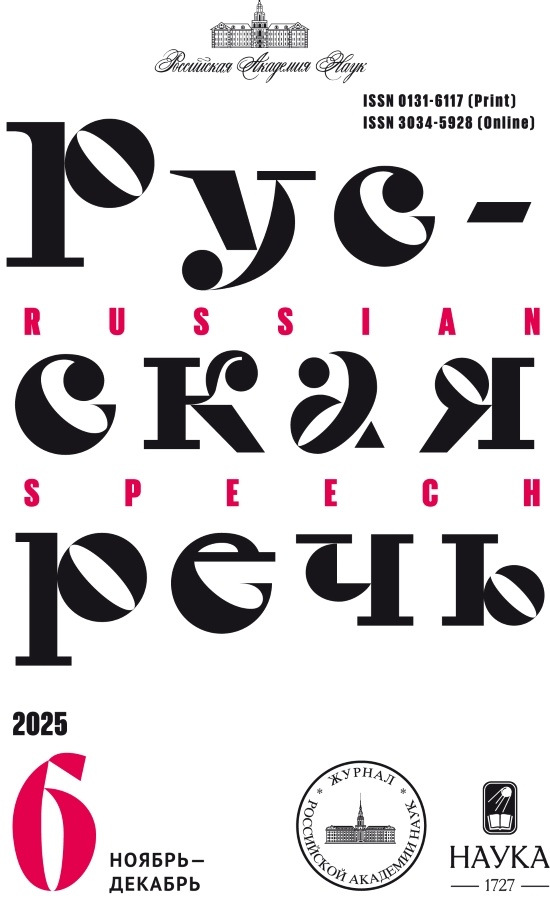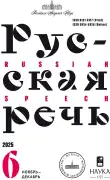Проблема семантической деривации слова "естественно"
- Авторы: Белов В.А.1, Шао М.1, Белова В.М.2
-
Учреждения:
- Санкт-Петербургский политехнический университет Петра Великого
- Национальный исследовательский институт "Высшая школа экономики"
- Выпуск: № 6 (2025)
- Страницы: 7-24
- Раздел: Проблемы современного русского языка
- URL: https://modernonco.orscience.ru/0131-6117/article/view/696180
- DOI: https://doi.org/10.31857/S0131611725060014
- ID: 696180
Полный текст
Аннотация
Статья посвящена семантической деривации слова "естественно", которое в русском языке может выполнять функции вводного слова, наречия, прилагательного, предикатива и частицы. Целью работы является анализ семантических и функциональных изменений при семантической деривации слова "естественно". Материалом исследования послужили данные Национального корпуса русского языка, а также сведения словарей русского языка. Гипотезой исследования является положение, что семантическая деривация слова "естественно" связана с усилением модусного содержания единицы и способности к диалогизации. В работе описаны семантические и синтаксические характеристики употребления слова в функции каждой части речи. По результатам исследования делается вывод, что в современной речи подавляющее большинство употреблений приходится на вводное слово. Семантическая деривация происходит за счет редукции пропозициональной группы в вводную конструкцию. Данная трансформация мотивирована усилением субъективного начала в речи и расширением функций в дискурсе. Употребление слова "естественно" выражает уверенность говорящего, основанную на знании типичного поведения в этой ситуации, которое также есть у слушателя. Данное слово является средством ведения непрямого диалога со слушателем. Семантическая деривация этого слова является следствием изменения неканонической (нарративной) коммуникативной ситуации, которая приобретает диалогические черты. Показателем семантической деривации является резкое увеличение частотности слова во второй половине XX века, в период развития средств массовой коммуникации, интерактивного общения и пр.
Об авторах
В. А. Белов
Санкт-Петербургский политехнический университет Петра Великого
Email: belov.vadim.a@gmail.com
Санкт-Петербург
Мань Шао
Санкт-Петербургский политехнический университет Петра Великого
Email: shao.man@yandex.ru
Санкт-Петербург
В. М. Белова
Национальный исследовательский институт "Высшая школа экономики"
Email: belova.valentina.m@gmail.com
Санкт-Петербург
Список литературы
- Апресян Ю. Д. (ред.). Новый объяснительный словарь синонимов русского языка. М.: Языки славянской культуры, 2003. 1488 с.
- Белошапкова В. А. (отв. ред.). Современный русский язык: Учебник для филол. спец. ун-тов / В. А. Белошапкова, Е. А. Брызгунова, Е. А. Земская и др. М.: Высшая школа, 1989. 800 с.
- Виноградов В. В. Русский язык (Грамматическое учение о слове): Учебное пособие для вузов. М.: Высшая школа, 1986. 640 с.
- Добрушина Н. Р. Исследования средств выражения обратной связи в американской лингвистике // Вопросы языкознания. 2000. No 1. С. 135-140.
- Дымарский М. Deus ex texto, или Вторичная дискурсивность набоковской модели нарратива // В. В. Набоков: pro et contra: в 2-х т. Т. 2. СПб.: РХГИ, 2001. С. 1-25.
- Евгеньева А. П. Словарь русского языка: В 4-х т. 4-е изд., стер. Т. 1. А-Й. М.: Русский язык; Полиграфресурсы, 1999. 702 с.
- Ефремова Т. Ф. Новый словарь русского языка. Толково-словообразовательный. М.: Русский язык, 2000. [Электронный ресурс]. URL: https://www.efremova.info (дата обращения: 05.10.2025).
- Зализняк А. А., Левонтина И. Б., Шмелев А. Д. Ключевые идеи русской языковой картины мира. М.: Языки славянской культуры, 2005. 544 с.
- Золотова Г. А., Онипенко Н. К., Сидорова М. Ю. Коммуникативная грамматика русского языка. М.: МГУ, 2004. 544 с.
- Киселева К., Пайр Д. Дискурсивные слова русского языка: опыт контекстно-семантического описания. М.: Азбуковник, 1998. 447 с.
- Китайгородская М. В. Чужая речь в коммуникативном аспекте // Русский язык в его функционировании: Коммуникативно-прагматический аспект. М.: Наука, 1993. С. 65-89.
- Кузнецова С. М. Системно-синтаксическое описание отадъективных модусных транспозитивов на -о: автореф. дисс. ... канд. филол. наук / МГУ имени М. В. Ломоносова. М., 2017. 23 c.
- Курилович Е. Очерки по лингвистике: Сборник статей. М.: Издательство иностранной литературы, 1962. 456 с.
- Кустова Г. И., Швелидзе Н. Б. Системные свойства апеллятивных вводных конструкций (по данным Национального корпуса русского языка) // Научно-техническая информация. Сер. 2. Информационные процессы и системы. 2020. No 9. С. 27-35.
- Ломтев Т. П. Предложение и его грамматические категории. М.: Издательство МГУ, 1972. 199 с.
- Национальный корпус русского языка [Электронный ресурс]. URL: https://ruscorpora.ru/ (дата обращения: 12.06.2024).
- Падучева Е. В. Эгоцентрические валентности и деконструкция говорящего // Вопросы языкознания. 2011. No 3. С. 3-18.
- Падучева Е. В. Эгоцентрические единицы языка. М.: Языки славянской культуры, 2019. 440 с.
- Панов М. В. Труды по общему языкознанию и русскому языку. Т. 1. М.: Языки славянской культуры, 2004. 568 с.
- Прохватилова О. А. Внутренняя диалогичность современной медиаречи // Вестник Волгоградского государственного университета. Сер. 2. Языкознание. 2020. Т. 19. No 2. С. 150-158.
- Ушаков Д. Н. (ред.). Толковый словарь русского языка: в 4 т. М.: Советская энциклопедия, 1935-1940. Электронная версия: https://ushakovdictionary.ru/ (дата обращения: 05.10.2025).
- Чейф У. Данное, контрастивность, определённость, подлежащее, топики и точка зрения // Новое в зарубежной лингвистике. Вып. XI. М.: Прогресс, 1982. С. 277-316.
- Шмелева Т. В. Мысли В. В. Виноградова о модальности и дальнейшее изучение этой семантической категории // Zbornik radova instituta za strane jezike i knjievnosti. Sveska 5. Нови Сад, 1983. С. 73-81.
- Foolen A. Pragmatic markers in a sociopragmatic perspective // Pragmatics of Society / Ed. by G. Andersen, K. Aijmer. Berlin, Boston: De Gruyter Mouton, 2012. P. 217-242.
- Fraser B. Pragmatic markers // Pragmatics. 1996. No 2. P. 167-190.
- Givón Т. Bio-linguistics: The Santa Barbara lectures. Amsterdam: John Benjamins Publishing Company, 2002. 383 p.
- Levinson S. Presumptive meanings: The theory of generalized conversational implicature. Cambridge: MIT Press, 2000. 480 p.








